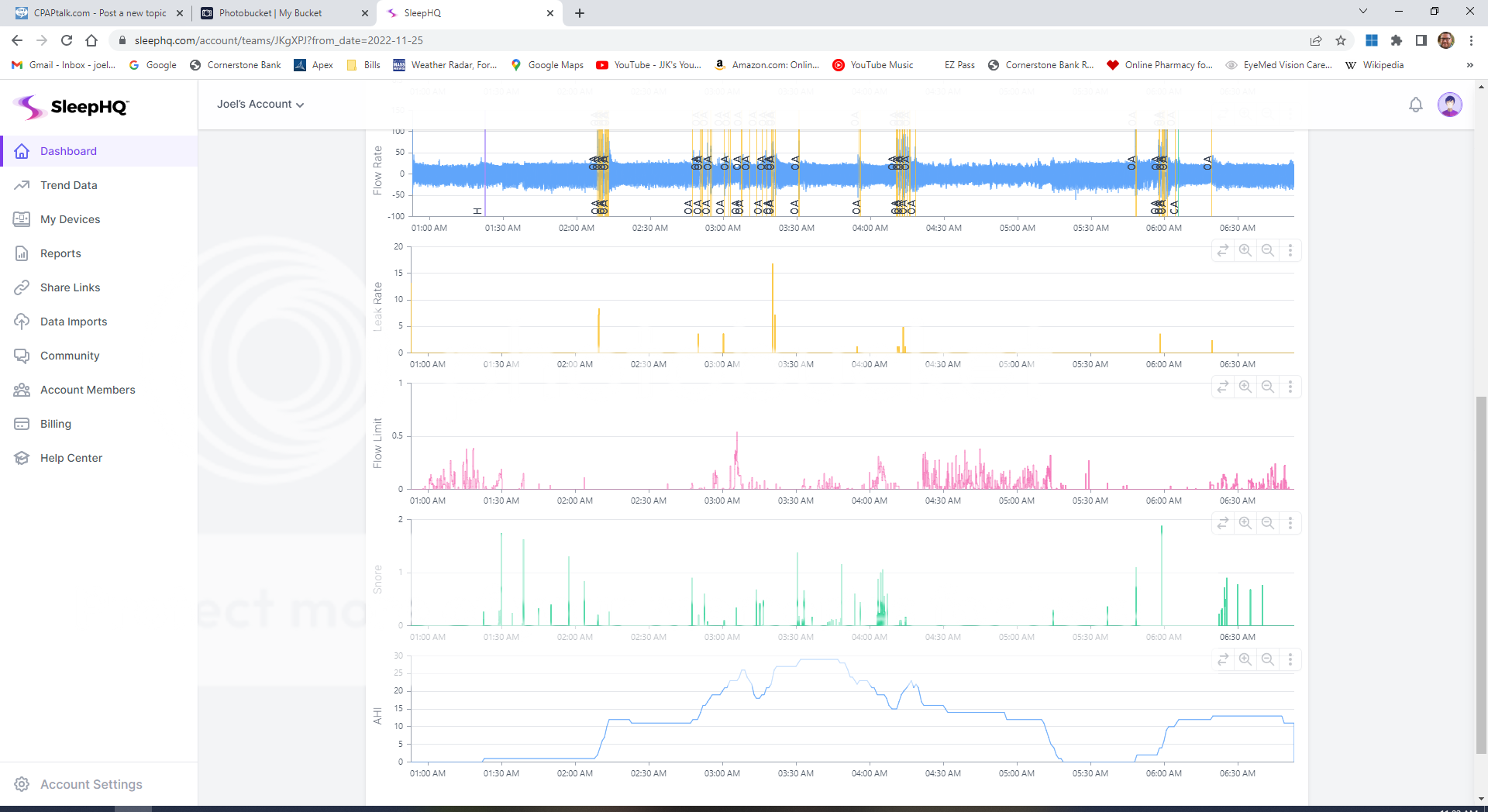joeljjk11 wrote: ↑Tue Nov 29, 2022 10:05 am
Can anyone help me read some of this data from sleep HQ?
If you would provide the link directly to the SleepHQ data, that would help us help you---the link will allow people here to zoom in on the parts of your data that are most relevant to answering your questions.
I have noticed that when I have my machine on APAP no matter what pressure it is at, it will jump to the maximum pressure almost all of the night.
You did
not include the pressure curve itself. Nor can we tell what APAP range you are using on either of the two nights that you posted. Without that information it's impossible to answer your questions.
My AHI is also bad when my pressure is high and bad when it is low.
Yes, your AHI is elevated on both nights. How high it actually is, however, can't be directly determined by the screenshots you posted.
Notably on this night:

Your flow limitations and snoring are much, much worse than on the other night that you post data for. Both flow limitations and snoring result in aggressive pressure increases when using a Resmed machine in APAP mode.
But even on the "better" night for flow limitations and snoring, there's still a lot of activity in those graphs:

And so I wouldn't be surprised to see some steep increases in the missing pressure curve for this night as well.
All of my apnea events seem to occur during REM sleep exclusively I have noticed also.
Did your sleep study indicate your apnea is worse in REM? And how are you attempting to associate the clusters of events flagged as OAs with REM sleep on these nights? I will admit that the
timing of some (but not all) of the clusters suggests possible REM sleep, but it's close to impossible to definitively say something is REM based on just the APAP data.
I feel better on straight pressure so this is what I have been using lately, at straight of 9.
The why switch to APAP in the first place? Or are the two nights that you posted data for from nights that you used CPAP at 9cm?
My sleep doctor has said that the machine flags these events as obstructive events but they are really central apnea events and this is what my in lab sleep study determined.
Yes, it's possible for the machine to mistakenly label CAs as OAs in some people's breathing. Zooming in on the data to the point where its possible to see the individual breaths can help to see if that's a potential issue.
And some people have a problem with CAs when the pressure gets too high. For the small minority of PAPers with problems with pressure-induced CAs, the problem usually gets worse (sometimes far worse) once the pressure is above 10cm.
But there's also an important question to ask:
If your in-lab sleep study determined that you have a problem with central sleep apnea, why were you prescribed an APAP machine?
For folks with a diagnosis of CSA (rather than OSA), the machine of choice is an ASV machine that is designed to stop the hypoventilation/hyperventilation cycles from getting started in the first place. An ordinary APAP/CPAP can't do that.
But if the problem on the in-lab sleep study was on the
titration study where you were sleeping with a CPAP, then the problem might not be a diagnosis of CSA, but rather a problem with pressure-induced central apneas emerging with CPAP treatment. In this case, the usual thing that is recommended is to see whether the centrals will "resolve" themselves after a few weeks (i.e. maybe 3-5 weeks) and no longer be an issue after the body adjusts to CPAP.
Sometimes a compromise on pressure has to be made: In other words, the CAs are not a real problem until the pressure reaches a certain point. And if the pressure needed to control the obstructive stuff---including flow limitations and snoring---is not too high, either limiting Max Pressure (in APAP mode) or using an appropriate pressure in CPAP mode is all that needs to be done to prevent the CAs from becoming problematic.
Also, sometimes EPR can be a culprit in triggering pressure-induced CAs. In other words, some people with pressure-induced CAs do better with EPR turned off or set to 1 than they do with EPR set to 3.
But for a very small number of PAPers with problems with pressure-induced CAs, the problem never fully resolves, even after several months of xPAP therapy. And for that unlucky tiny minority, the usual "fix" is to go back to the lab for an ASV titration.
Joined as robysue on 9/18/10. Forgot my password & the email I used was on a machine that has long since died & gone to computer heaven.
Correct number of posts is 7250 as robysue + what I have as robysue1
Profile pic: Frozen Niagara Falls





